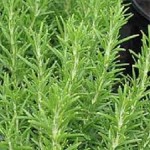
Rosemary is one of those herbs with a thousand uses. It’s extremely hardy and therefore easy to grow and maintain inside or out. It is prepared as a dried whole herb or a dried powdered extract, useful as a tea and magic as a medicinal herbal liquid extract for increasing alertness, reducing tension headaches and increasing phase II liver metabolism. But my interest lies with rosemary’s ursolic acid content.
Rosemary is rich in ursolic acid (U.A) also found and in the wax-like coatings of apples, pears and prunes. In Shanmugam et al., (2013) review, they investigated the many possible pathways that U.A has proven to be anti-carcinogenic. All studies mentioned in the review are in vitro and in vivo, but success in multiple types of cancers including lung, colorectal, skin, leukemia, reproductive, hepatic and pancreatic are documented.
Considering an estimation that 1/3 of all cancer related deaths in the USA can be prevented through dietary modification (Venugopal & Lui 2012), the consumption of phytochemicals such as rosemary and ursolic acid containing fruits can create ample hope in the reduction and prevention of world-wide cancer rates – how cool is that!



Recent Comments